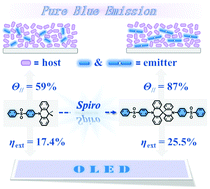High-efficiency pure blue thermally activated delayed fluorescence emitters with a preferentially horizontal emitting dipole orientation via a spiro-linked double D–A molecular architecture†
Abstract
Blue as one of the three primary colors is of great significance for lighting and full-color displays, and the development of blue emitters with satisfactory color purity and high efficiency is still a formidable challenge for organic light-emitting diodes (OLEDs). In this study, a spiro-linked double donor–acceptor (D–A) molecular architecture is introduced to selectively improve the horizontal emitting dipole orientation of blue emitters and thereby boost the electroluminescence (EL) performance of blue OLEDs. To testify the validity, a thermally activated delayed fluorescence (TADF) emitter, namely SBA-2DPS, is designed by connecting two D–A pairs with a sp3 hybrid carbon atom. Compared to the prototypical emitter DMAC-1DPS, the shape of SBA-2DPS is elongated dramatically without expanding the degree of π-conjugation owing to the σ-spacer linkage. Consequently, a high horizontal dipole ratio (Θ‖ = 87%) is achieved for SBA-2DPS. Besides, SBA-2DPS exhibits high thermal stability, pure blue emission and distinct TADF characteristics. OLEDs based on SBA-2DPS exhibit an external quantum efficiency (ηext) of 25.5% and favorable Commission International de l’Eclairage (CIE) coordinates of (0.15, 0.20). Such an inspiring performance is rationalized by their high out-coupling efficiency (Φout = 38.2%) and the optical microcavity effect. Unambiguously, this finding demonstrates the validity of the spiro-linked double D–A molecular architecture in constructing good blue TADF emitters with a preferentially horizontal emitting dipole orientation for high-efficiency blue OLEDs.

- This article is part of the themed collection: Editor’s Choice: Spiro compounds for electronics


 Please wait while we load your content...
Please wait while we load your content...